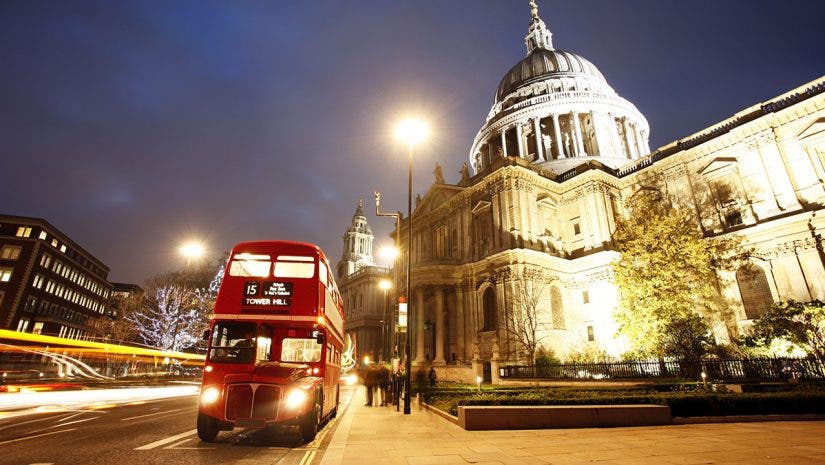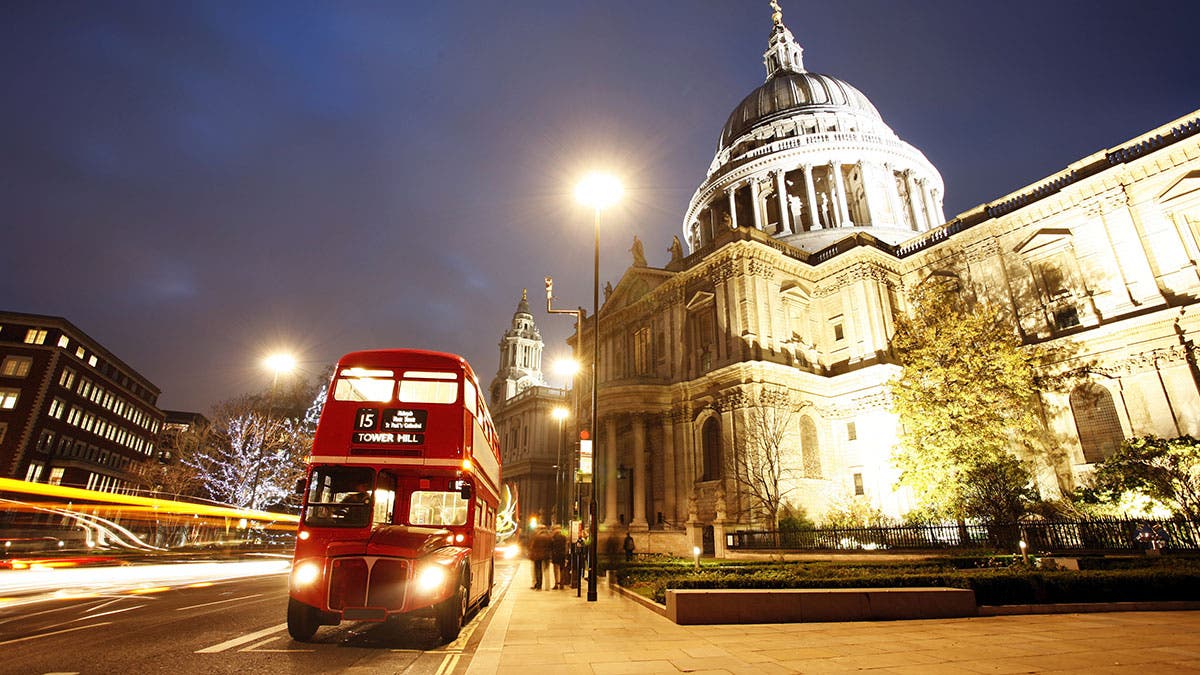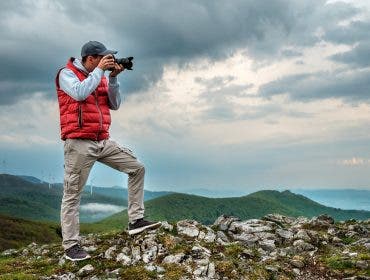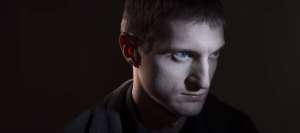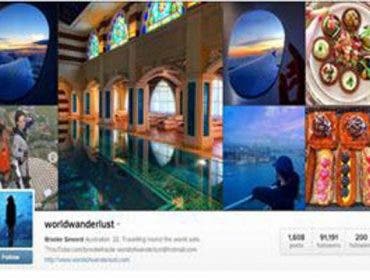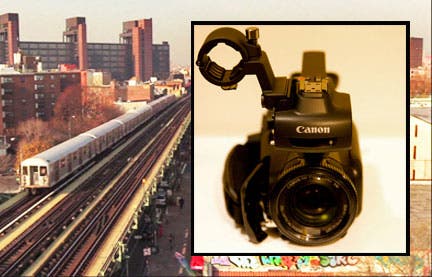It’s summer, vacation time, and for many—this year especially—London’s calling. We’ve already seen the Queen’s Diamond Jubilee, celebrating her remarkable 60 years on the Throne, and in a few weeks, London will play host to the Olympics.
London is the foreign destination that doesn’t seem so alien and many of you will be heading over. While for the past four years I’ve been a New Yorker, I was a Londoner for 11 years before that. I’ve come to love London, its neighborhoods, its streetscapes, and especially its people and its culture. It is one of the great cities of the world, and like all truly ‘world-class’ cities, it doesn’t need to say so. As a resident of the multicultural, polyglot urban conglomeration that is London, I found my voice as a street photographer.
Related articles at the Adorama Learning Center:
- Digital Cameras for Street Photography: An Opinionated Guide
- What’s a Street Photography Stress Test and Why Should You Care?
- Sidewalk Serendipity: The Challenge and Joy of Street Photography
For me, London isn’t taking pictures of great monuments and sights like the Tower of London, Trafalgar Square, St. Paul’s, the Houses of Parliament or Buckingham Palace. While anyone going for the first, second, or even fifth time to London will certainly take pictures of the sights, the challenge is to make something interesting out of it, not just a record shot that says ‘I was here in front of the Horse Guards in Whitehall.’
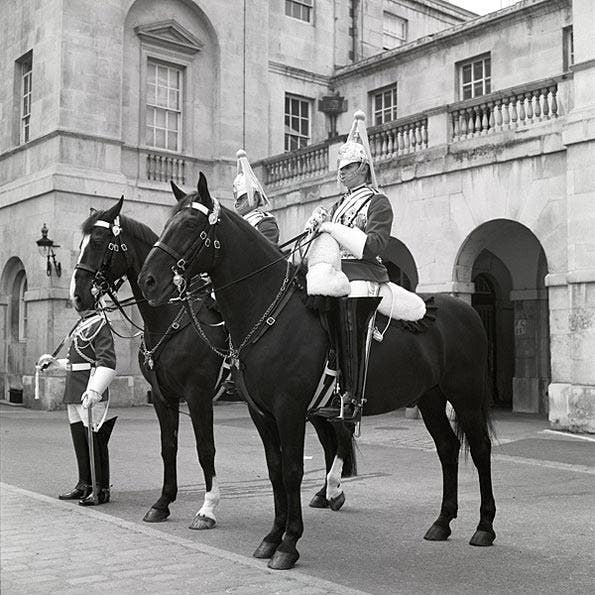
Horse Guards, 2003. I saw the picture possibility here right away, but had to move from side-to-side quickly to line up this photo with the Guard just right. There were lots of other people around too, so it was delicate; you just can’t shove people aside. But if one is polite, quietly saying ‘excuse me, please,’ more often than not you will be able to get where you need to be. Rolleiflex f/2.8 Planar, Kodak Tmax 400.
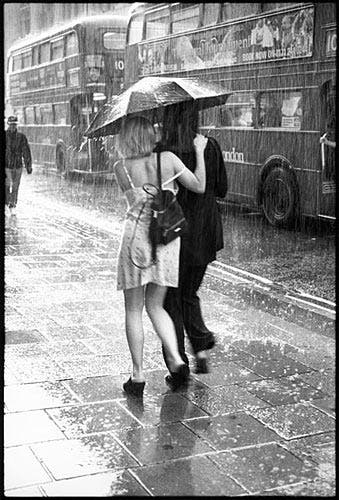
Oxford Street, 1998. A quick shot of a red double-decker bus may say that you were in London, but not be a very interesting photograph in itself. But if you are photographing people and that bus is in the background, you will have both the memory and an interesting photograph. A bit of luck in the form of a sudden summer shower helps too; bad weather can make good photographs. Leica M3, 35mm Summicron, Kodak TMax 400. Exposure not recorded.
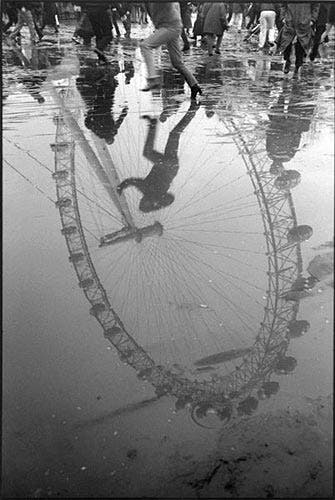
Millennium Wheel, 1999. Leica M6, 35mm Summicron, Kodak TMax 400.
What makes London special is that it is a city for walking, made up of ancient villages that grew until they ran into each other. The streets are crooked, winding, short, narrow, and confoundingly change their names every few blocks. The scale of the cityscape is human: low, warm, engaging and ever-changing, very unlike the tall, overwhelming rectangular grid of New York.
There is always something different to be seen around every corner. You just never know what you’ll find. One evening I was cutting through a back lane on my way home from the lab and saw this:
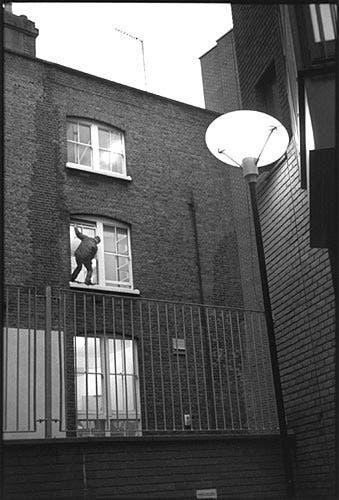
Second Story Man, Clerkenwell, 2004. What is he doing? Why is he out there on a tiny third-story ledge? These unanswered questions are just what make this photograph work. Keep your camera ready and your eyes open! Leica M6, 35mm Summicron, Kodak TMax 400.
So, here are some thoughts for those of you who will be wandering those streets this summer. First, though, a thought on my approach to street photography:
To me, the best photographs are unposed, portraying people as they are, going about their lives as if I were not there at all. These are arguably much harder to take, but more rewarding when you get a good one. If you ask permission first, (and you get it) you will certainly get a photo—perhaps even a good one—but it will not be what drew your eye in the first place.
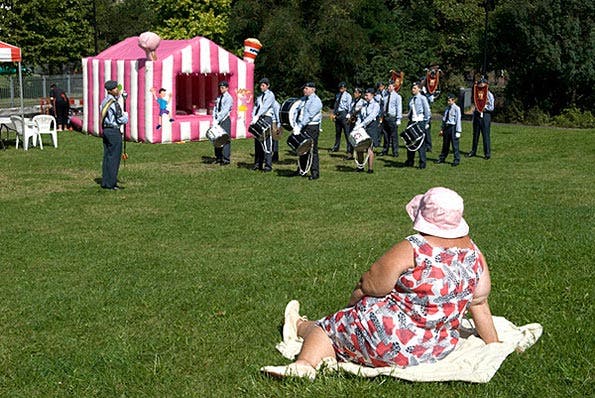
Limehouse Spectator, 2007: If I asked this lady for permission, assuming she agreed, she would have turned around and smiled, but the moment would be gone, the band moved into a different position, and the picture lost. Nikon D200 at ISO 400, 17-55 f/2.8 Nikkor-Zoom.
There are many factors in London as well as most big cities that work in your favor shooting on the streets:
- Cameras and tourists are everywhere, so the fact that you have one and are one as well is no big deal. You will generally be ignored by the locals, who easily recognize someone who is ‘not from here.’
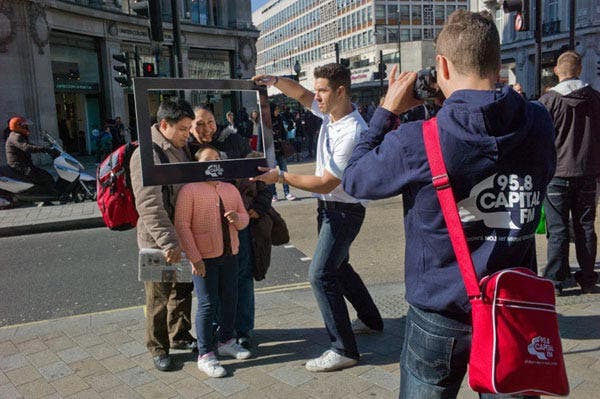
Framed, 2011. Leica M9, 35mm Summicron, ISO 800
- People in a city are busy and distracted; their minds are on other things as they go about their business.
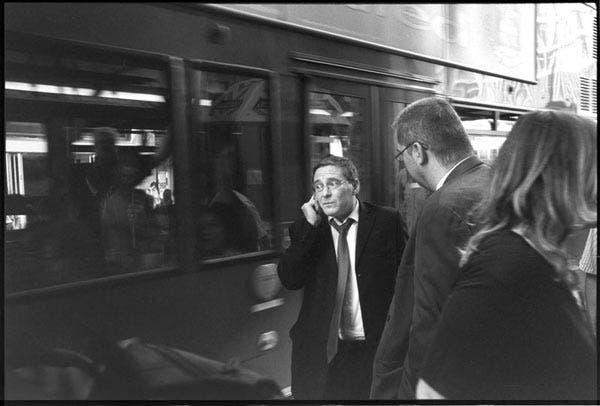
Oxford Street Man, 2005. Leica M6, 35mm Summicron, Kodak TMax 400.
Many of the best shooting streets are bustling, and it is easy to openly hide in the midst of the crowd.
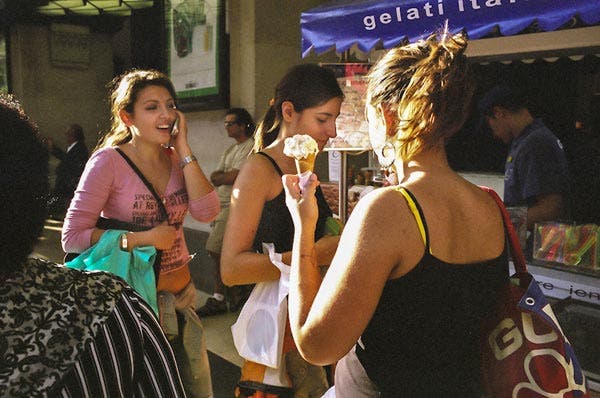
Gelati, Selfridge’s, Oxford Street, 2006. Leica M6, 35mm Summicron, Fujicolor 400.
Favorite spots
So where are my favorite places to photograph people in London? First and foremost is the West End, what most people think of as Central London. This is the area around Oxford Street, Regent Street, and Piccadilly, encompassing the Covent Garden, Leicester Square, Soho, and Fitzrovia neighborhoods. This is the main shopping and entertainment area of the city. There are always people out and about, and on a weekend with good weather, there is a constant crush of people, something I love. Advertising is big and bold, giving the alert shooter great backgrounds to work with.
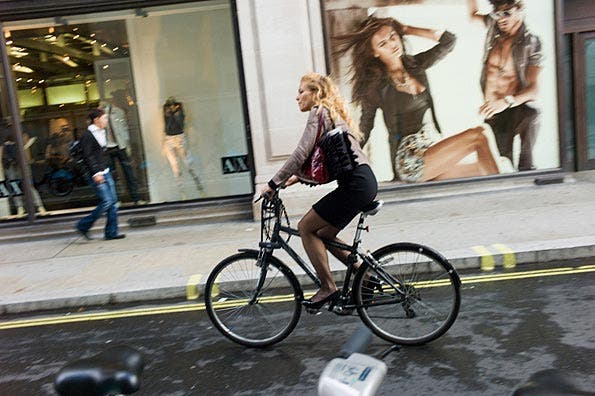
Cyclist, 2010. Leica M9, 35mm Summicron, ISO 320.
Oxford Street in particular is a favorite: People don’t pay attention to another person with a camera. Also at certain times of the day, the light flows down the street, reflecting from the windows from one side of the street to the other making little spotlights for the actors—that is, the pedestrians—to walk into and through. Most of the photographs in this article were taken within a few blocks of Oxford Circus, the intersection of Oxford and Regent Streets.
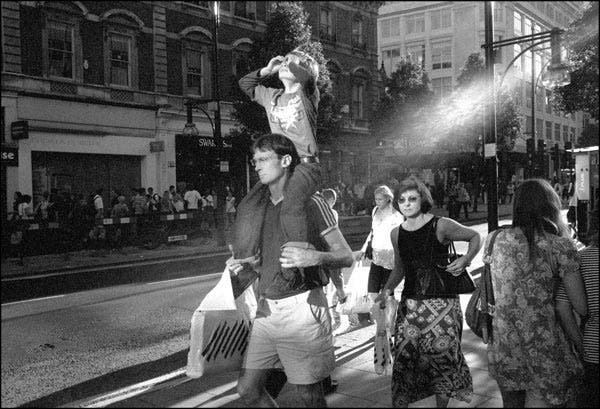
Oxford Street Goggles 2007. Leica M6, 35mm Summicron, Kodak TMax 3200.
Another favorite place for me has always been public transport, especially the London Underground, mostly because I rode it all the time just getting from one place to another. Although you might be questioned by police in these paranoid times, it is quite legal to take pictures in the Underground as long as you DO NOT USE FLASH! (There is a practical reason for this: If one takes a flash picture of the front of a train coming into the station, it momentarily blinds the driver! He works in the dark and it can take several minutes for his eyes to readjust. This will delay the train and the London train driver will publicly scold you on the PA system.)
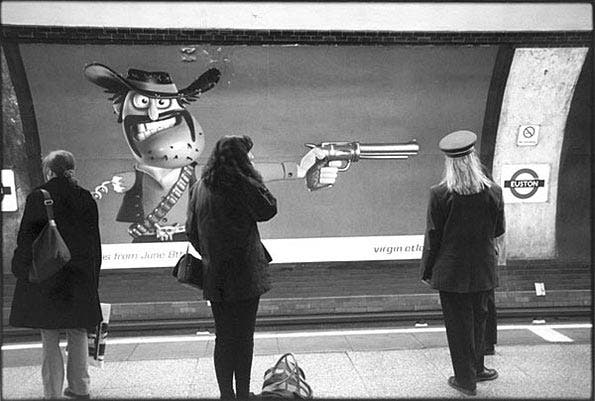
Gunslinger, 2000. Leica M6, 35mm Summicron, Kodak TMax 400.
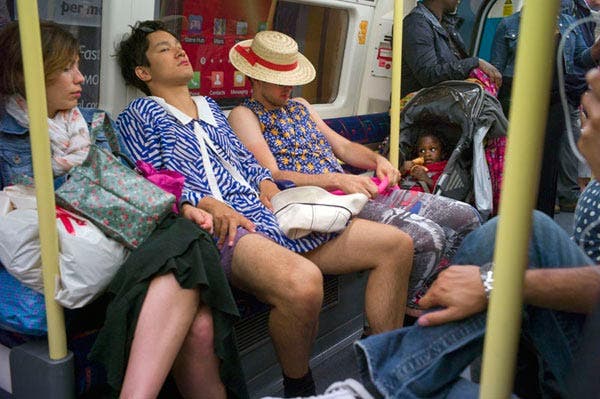
Costumed Couple, 2011. A note on this one: Beware the siren call of the silly costume! People in costumes in public are not necessarily interesting or funny. It takes something extra to make it work – in this case, the eyes of the baby looking at them. Without her, the photo is just two hung-over guys on a train in silly clothes. Leica M9, 35mm Summicron, ISO 800.
Further locations
Old Carnaby Street—in the 1960’s the center of the trendy universe—is now another standard shopping street, but a bit east are several small lanes leading into Soho that still have unique little boutique shops.
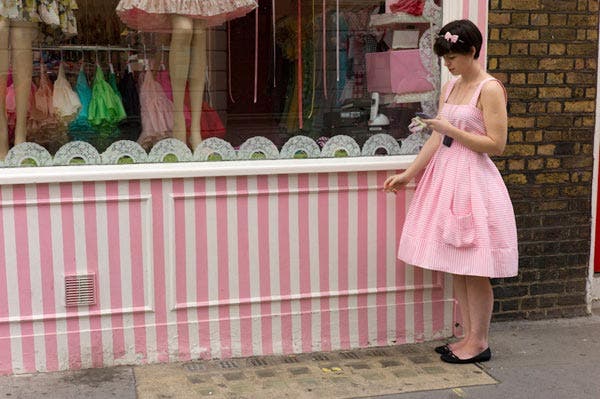
Candy Stripe, 2010. Leica M9, 35mm Summicron, ISO 400.
Covent Garden is full of little shops and lots of people patronizing them. There are lots of street performers, and the tourists watching them are always worth a shot or two.
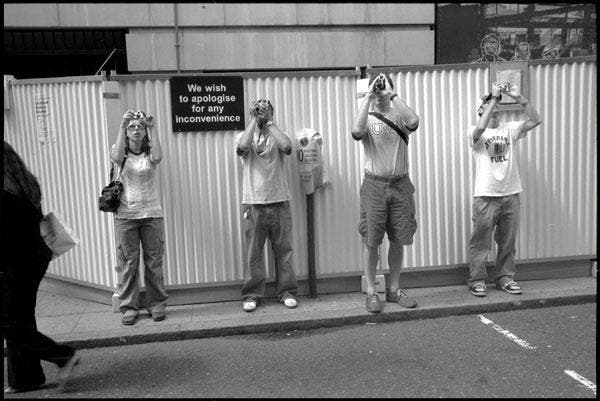
We Apologize, 2006. Leica M6, 35mm Summicron, Kodak TMax 400.
Even more places
- The Royal Parks, especially St. James and Hyde Parks, are always full of people relaxing, strolling, gawking, and just looking at the flowers.
- The City of London, from St. Paul’s Cathedral to Leadenhall Market. This is the “Square Mile,” the once-walled ancient City, now the heart of business and the British equivalent of Wall Street. At lunch time suited bankers and brokers are out enjoying a pint or two away from the office.
- The East End, from Spitalfields to Brick Lane, up to Shoreditch and Columbia Road. Brick Lane is the center of the Bangladeshi Community, and the heart of the immigrant East London. First the French Huguenots, then Eastern European Jews, and now Indians and Bangladeshis have filled the neighborhood in successive waves. The latest ‘immigrant’ group is the young and hip, and little new design shops and clubs are scattered about its lanes.
- On Sunday mornings, the Columbia Road Flower Market is a delightful heaving mass of people and vegetation, with vendors shouting their wares to all comers in a riot of color.
Some thoughts on equipment
What camera is the best for street photography? Glib answer: One that works. Seriously, I’m partial to the Leica M rangefinder series with wide-angle lenses, primarily the 35mm and 24mm focal lengths. (Many of my colleagues swear by the 28mm, but it’s never worked for me; a matter of personal taste.) They work the way I prefer: small, quiet and unobtrusive. However, even used, these are very pricey with the lenses and they are not for everyone. They are stripped-down, basic, and have almost no automatic functions. Owning a Leica will not by itself make you a better photographer.
There are a lot of great cameras out there but I will only speak about those I personally know and have used. My SLR/DSLR gear is all Nikon and has been since I became a photographer back in 1984. My current model is the D700, a full-frame excellent workhorse. I tend to use my older prime lenses, primarily the 24mm and 35mm, rather than zooms as much to save weight as anything else. For a light point-and-shoot, I like the Canon PowerShot G12. The shutter-lag is minimal and it has manual over-rides to tweak the well-designed automatic functions. Another well-priced pocket-sized camera is the Panasonic LX-5 from their Lumix series. It has an exquisite Leica lens and is very straightforward and fast in use. Check out Mason Resnick’s Opinionated Guide to Alternative Street Photography cameras for the current, tested best of breed.
DO NOT take a brand-new, never-used unfamiliar camera with you on your special vacation. Whatever camera you have with you, DSLR, rangefinder, or camera-phone, learn it backwards and forwards before you go so you can use it fast! Know what it will do and what it won’t do. All cameras have their limitations, so work within them. With most compact or point-and-shoots the biggest problem is shutter lag: learn to anticipate and compensate for it. The difference between getting a good photo and an ordinary one is a fraction of a second. The moment will not wait while you’re fiddling with the gear. (As my mother used to say to my father on family vacations, “Bob, while you’re fiddling with that camera, the herd of buffalo is moving on.”)
Seven things you should know about shooting in the streets:
1. Leave the lens cap in your hotel room. It will only be in the way.
2. If you are nervous about getting close to your subjects, the best place to get over it is a big public event, like a parade or street fair. There are crowds of people, all with cameras, all taking pictures right and left. You will not be noticed. Dare yourself to see how close you can get to your subject. Can you take a picture of a stranger while standing right next to them? A big crowd is the place to practice.
3. The most important piece of equipment: sturdy, comfortable shoes.
4. Only show your best pictures. Never show anyone everything. That way you will always be thought of as a good photographer!
5. A soft voice and a polite manner will get you through almost anything.
6. If people see you, they see you. Respect your subjects as fellow human beings. If someone says, “Don’t take my picture,” don’t take their picture! There are always more people and more photographs elsewhere. “The better part of valour is discretion” said Shakespeare’s Falstaff.
7. Taking photographs of people in public is NOT against the law in either Britain or the United States. It is completely legal to take pictures of people without permission in a public place, street, plaza, public transport and so on. Police generally know this now, though in these times of paranoia they may choose to forget it. Private security guards may be your biggest problem. Even if they know the law, they will try to intimidate you. Again, playing a quiet silly tourist can get you out of a tricky spot, and they cannot by law force you to show them your images nor make you delete them. This video, made last year for the London Street Photography Festival, will give you an insight into what you can and can not do. Also see Champions of Photographers’ rights.
London is a vibrant, exciting, young city, the most dynamic in all of Europe. This is what makes it fun: It is different from home. That’s why we go to foreign places, to experience a different way of life. If you forget all of your preconceptions and don’t go looking for them, you will have a fantastic time and bring home great photographs.
—Richard Bram
All photos © Richard Bram
